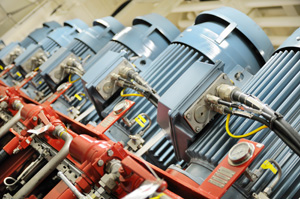
 Over half of all the electricity used by US industrial plants goes to power electric motors; they’re found in nearly every manufacturing plant and commercial operation. Consequently, the most common application of rotary encoders is for the control of speed and direction of electric motors, from small frame steppers to large AC induction vector-duty NEMA motors. Today’s sophisticated drives and control systems can use feedback from a single motor mount encoder to control multiple axes of motion.
Over half of all the electricity used by US industrial plants goes to power electric motors; they’re found in nearly every manufacturing plant and commercial operation. Consequently, the most common application of rotary encoders is for the control of speed and direction of electric motors, from small frame steppers to large AC induction vector-duty NEMA motors. Today’s sophisticated drives and control systems can use feedback from a single motor mount encoder to control multiple axes of motion.
Mechanically, shaft encoders mount directly to the motor via a bell housing and attach to the shaft via a flexible coupling. Also, a shaft encoder also can be indirectly applied to the motor via a chain and sprocket or belt and pulley. In recent years, most motor manufacturers have opted for through bore or hollow bore encoders due to the compact design and reduced bearing loads. In this case the encoder attaches to the motor via a thin, flexible one, two or three point flex-mount, while the encoder is fixed to the shaft via a collar. C-Face encoders have flange and bolt circle features that permit direct application to C-Face motor surfaces, providing a seamless, integrated encoder/motor assembly.
Electrically, incremental quadrature encoders with resolutions of 1024 and 2048 CPR are commonly used, with commutation tracks and other resolutions used when needed to accommodate controller input requirements. High voltage line driver (EPC’s HV output) is an excellent output type for motor applications due to its resistance to electrical noise. Certain control systems and motor applications may require absolute shaft position for motor feedback, but incremental signals are used for the vast majority.
Environmentally, motor feedback can be very demanding on encoders due to high temperatures, especially when enclosed in an unventilated servo-motor housing. Thus, EPC recommends specifying the encoder’s highest available temperature rating for motor applications.
Examples: